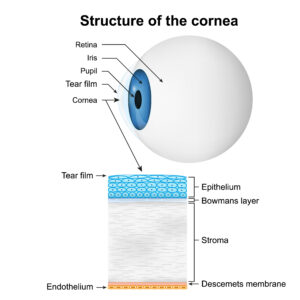Posted by: Manhattan LASIK Center
When you wake up, do you dream of crisp, clear vision without needing glasses or contact lenses? Refractive laser eye procedures, also known as laser vision correction, are an increasingly popular alternative to glasses and contact lenses.
There’s a good chance you’ve heard of LASIK, which is the most well-known and popular laser eye procedure. But it’s not the only one you can undergo!
There are several laser vision correction procedures! One important thing to consider when deciding which procedure to undergo is your corneal thickness.
Although you probably don’t know how thick your cornea is, it’s something that’s measured when you come in for a consultation for a laser vision correction procedure at Manhattan LASIK Center. It’s especially crucial when it comes to determining your candidacy for LASIK.
This is because of how these laser vision correction procedures work and correct vision. Keep reading to learn why corneal thickness matters and how it affects your candidacy for different refractive laser eye procedures like LASIK!
What are Refractive Laser Eye Procedures?
The goal of refractive laser eye procedures is to correct refractive errors. Refractive errors include nearsightedness, farsightedness, and astigmatism.
They occur when the cornea is an irregular shape, leading to distorted vision. The cornea is the transparent front part of your eye that light passes through.
The cornea’s job is to bend the light to hit a focal point at the right place inside your eye, called refraction. When you have a refractive error, light doesn’t hit the focal point correctly or at the right place. If this occurs, it makes images appear blurry at certain distances.
Refractive procedures use a laser to sculpt the cornea and reshape it. Reshaping the cornea corrects irregularities and corrects any refractive errors.
These procedures permanently change the shape of the cornea. However, to do this, your surgeon must safely have access to the cornea.
This ensures the eye can heal after the procedure with minimal corneal scarring. Different forms of laser vision correction use other methods of accessing the cornea. Some of these require a certain amount of corneal thickness.
PRK
PRK was the first refractive procedure invented, providing patients with virtually identical results to LASIK. PRK allows access to the cornea by removing the thin, protective layer around the cornea called the epithelium.
The epithelium is removed by scraping it off the surface of the cornea. Unlike other vision correction procedures like LASIK, no flap is created during PRK.
Instead, an excimer laser will reshape the cornea to correct refractive errors. The epithelium regenerates and grows back after a few weeks. You’ll have to wear special contact lenses to protect your eyes during healing.
While PRK is a safe and effective vision correction procedure, it takes longer to see visual improvement, and recovery takes more time.
Patients also may be more uncomfortable while recovering from PRK. However, PRK is an excellent choice if you’ve been told that your corneas are too thin to undergo LASIK safely.
LASIK
Compared to PRK, LASIK is preferable to PRK because recovery is faster, and patients see visual improvement immediately after the procedure. This is because of how the cornea is accessed during LASIK.
A femtosecond laser makes a flap at the top of the cornea. This laser separates tissue without disturbing the surface of the eye.
The laser separates a section from the top of the cornea except for a small hinge of tissue so the flap can be lifted and replaced after surgery. Once the flap is lifted, an excimer laser is then used to reshape the middle corneal tissue found under the flap.
The corneal flap makes it easier for the eye to heal after LASIK as it acts as a natural bandage. However, the cornea must be thick enough to allow for the creation of a flap.
If your corneas are too thin, you cannot safely have LASIK surgery. During your LASIK consultation at Manhattan LASIK Center, one of the things we will measure is the thickness of your corneas.
Many people with thin corneas have had to turn to PRK, which doesn’t require creating a corneal flap. But there’s another option for flapless refractive procedures that allows immediate visual improvement and fast recovery— SMILE.
SMILE
SMILE, or Small Incision Lenticule Extraction, is a no-flap refractive laser eye procedure. Like LASIK, it uses a femtosecond laser.
But unlike LASIK and PRK, it doesn’t use an excimer laser. The femtosecond laser creates a disc-shaped piece of tissue from the cornea called a lenticule under the cornea’s surface.
The lenticule is then pulled out through a small incision. This method makes SMILE the most minimally invasive vision correction procedure you can undergo.
Recovery is fast, and patients see immediate visual improvement. Because no flap is required, corneal thickness is not as important. Often, patients who have been told that their corneas are too thin for LASIK will be better candidates for SMILE.
Remember that SMILE can only correct nearsightedness and low levels of astigmatism, whereas PRK and LASIK can also correct farsightedness and higher levels of astigmatism. Although SMILE is not suitable for everyone, it may be the vision correction procedure you’ve been searching for.
After all, it’s a minimally invasive procedure that has incredible outcomes. Most patients end up with 20/20 vision or better.
By choosing SMILE, you can achieve total visual freedom from glasses and contact lenses while enjoying your best vision like many of our patients. Why should the thickness of your corneas stand in the way of crisp, clear sight? With SMILE, it doesn’t have to!
Are you ready to change your life? To learn more, request an appointment today at Manhattan LASIK Center in Westchester, NY, for your commitment-free SMILE consultation! Isn’t it time to see the world with the kind of vision most people can only dream about?




